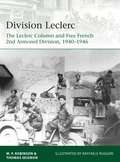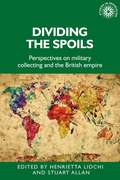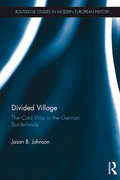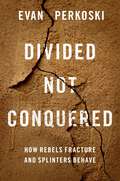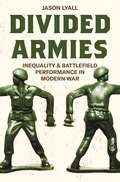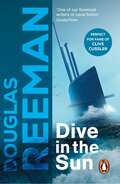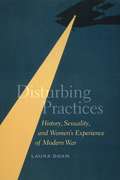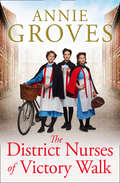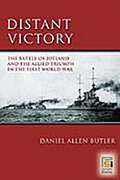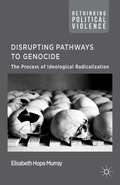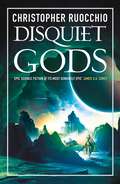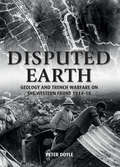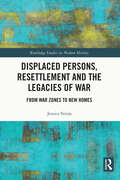- Table View
- List View
Division Leclerc: The Leclerc Column and Free French 2nd Armored Division, 1940–1946 (Elite)
by Raffaele Ruggeri Merlin Robinson Thomas Seignon'General Leclerc' was the nom de guerre adopted by the Gaullist officer Philippe de Hautcloque, to protect his family in occupied France. He became France's foremost fighting commander, and his armored division (the '2e DB') its most famous formation. Starting as a small scratch force of mostly African troops organised and led by Leclerc in French Equatorial Africa, it achieved early success raiding Italian and German positions in co-operation with Britain's Long Range Desert Group. Following the Allied victory in North Africa it was expanded and reorganised as a US Army-style armoured division, with American tanks and other armoured vehicles. Shipped to the UK, in spring 1944, it was assigned to Patton's US Third Army, landing in time for the Normandy breakout and being given the honour of liberating Paris in August 1944. Combining a thorough analysis of their combat and organisation with detailed colour plates of their uniforms and equipment, this is the fascinating story of Free France's most effective fighting force.
Division Leclerc: The Leclerc Column and Free French 2nd Armored Division, 1940–1946 (Elite)
by Raffaele Ruggeri Merlin Robinson Thomas Seignon'General Leclerc' was the nom de guerre adopted by the Gaullist officer Philippe de Hautcloque, to protect his family in occupied France. He became France's foremost fighting commander, and his armored division (the '2e DB') its most famous formation. Starting as a small scratch force of mostly African troops organised and led by Leclerc in French Equatorial Africa, it achieved early success raiding Italian and German positions in co-operation with Britain's Long Range Desert Group. Following the Allied victory in North Africa it was expanded and reorganised as a US Army-style armoured division, with American tanks and other armoured vehicles. Shipped to the UK, in spring 1944, it was assigned to Patton's US Third Army, landing in time for the Normandy breakout and being given the honour of liberating Paris in August 1944. Combining a thorough analysis of their combat and organisation with detailed colour plates of their uniforms and equipment, this is the fascinating story of Free France's most effective fighting force.
Dividing the spoils: Perspectives on military collections and the British empire (Studies in Imperialism)
by Alan LesterAt a time of heightened international interest in the colonial dimensions of museum collections, Dividing the Spoils provides new perspectives on the motivations and circumstances whereby collections were appropriated and acquired during colonial military service. Combining approaches from the fields of material anthropology, imperial and military history, this book argues for a deeper examination of these collections within a range of intercultural histories that include alliance, diplomacy, curiosity and enquiry, as well as expropriation and cultural hegemony. As museums across Europe reckon with the post-colonial legacies of their collections, Dividing the Spoils explores how the amassing of objects was understood and governed in British military culture, and considers how objects functioned in museum collections thereafter, suggesting new avenues for sustained investigation in a controversial, contested field.
Dividing the spoils: Perspectives on military collections and the British empire (Studies in Imperialism)
by Alan LesterAt a time of heightened international interest in the colonial dimensions of museum collections, Dividing the Spoils provides new perspectives on the motivations and circumstances whereby collections were appropriated and acquired during colonial military service. Combining approaches from the fields of material anthropology, imperial and military history, this book argues for a deeper examination of these collections within a range of intercultural histories that include alliance, diplomacy, curiosity and enquiry, as well as expropriation and cultural hegemony. As museums across Europe reckon with the post-colonial legacies of their collections, Dividing the Spoils explores how the amassing of objects was understood and governed in British military culture, and considers how objects functioned in museum collections thereafter, suggesting new avenues for sustained investigation in a controversial, contested field.
Divided Village: The Cold War in the German Borderlands (Routledge Studies in Modern European History)
by Jason B. JohnsonIn 1983, then-US Vice President George H.W. Bush delivered a speech in London. He had just been in West Berlin and spoke about his first visit to the Berlin Wall. Bush then went on to describe another German wall he saw after Berlin: "if anything, that wall was an even greater obscenity than its eponym to the north." The story of that wall is a fascinating and valuable slice of the history of post-war Europe. That wall had gone up nearly two hundred miles southwest of Berlin at the edge of divided Germany, in the tiny, remote farming village of Mödlareuth. For nearly half the twentieth century, the Iron Curtain divided Mödlareuth in two. In this little valley surrounded by forests and fields, the villagers of Mödlareuth found themselves on the literal front-line of the Cold War. The East German state gradually militarized the border through the community while eastern villagers exhibited a range of responses to cope with their changing circumstances, reflective of the variable nature of the Cold War border through Germany: along the Iron Curtain, the size and isolation of the divided place influenced the local character of the division.
Divided Village: The Cold War In The German Borderlands (Routledge Studies in Modern European History)
by Jason B. JohnsonIn 1983, then-US Vice President George H.W. Bush delivered a speech in London. He had just been in West Berlin and spoke about his first visit to the Berlin Wall. Bush then went on to describe another German wall he saw after Berlin: "if anything, that wall was an even greater obscenity than its eponym to the north." The story of that wall is a fascinating and valuable slice of the history of post-war Europe. That wall had gone up nearly two hundred miles southwest of Berlin at the edge of divided Germany, in the tiny, remote farming village of Mödlareuth. For nearly half the twentieth century, the Iron Curtain divided Mödlareuth in two. In this little valley surrounded by forests and fields, the villagers of Mödlareuth found themselves on the literal front-line of the Cold War. The East German state gradually militarized the border through the community while eastern villagers exhibited a range of responses to cope with their changing circumstances, reflective of the variable nature of the Cold War border through Germany: along the Iron Curtain, the size and isolation of the divided place influenced the local character of the division.
Divided Not Conquered: How Rebels Fracture and Splinters Behave
by Evan PerkoskiFrom terrorist disputes to splinter offshoots, an inside look at how armed groups break apart. Terrorist, rebel, and insurgent groups are highly unstable. Amid fears of defeat and even death, intense disagreements have torn many organizations apart, from Syria to Iraq, Ireland to Spain. And while some of these divisions have preceded a group's decline and eventual defeat, others have launched some of the most notorious and deadly organizations in recent history. In Divided Not Conquered, Evan Perkoski analyzes how armed groups fracture and how breakaway splinter groups behave. Perkoski takes an unprecedented look inside these organizations to understand the specific disagreements that cause groups to break apart, like those over ideology, leadership, and strategy. Drawing on research from organizational studies to social psychology, and leveraging analogies from business firms to religious sects, Perkoski shows how these disputes uniquely shape the behavior and survivability of emerging splinters. When motivated by single, shared disagreements, splinters exhibit higher cohesion, clearer objectives, and greater survivability. When motivated by strategy, splinters attract hardline operatives who steer the group towards increasingly lethal tactics and strategies. Including case studies of republican militants in Northern Ireland, Basque militants in Spain, and the Islamic State in Syria and Iraq, Divided Not Conquered demystifies a complex yet common phenomenon with ramifications for counterinsurgency, counterterrorism, and our understanding of increasingly fragmented conflicts around the globe.
Divided Not Conquered: How Rebels Fracture and Splinters Behave
by Evan PerkoskiFrom terrorist disputes to splinter offshoots, an inside look at how armed groups break apart. Terrorist, rebel, and insurgent groups are highly unstable. Amid fears of defeat and even death, intense disagreements have torn many organizations apart, from Syria to Iraq, Ireland to Spain. And while some of these divisions have preceded a group's decline and eventual defeat, others have launched some of the most notorious and deadly organizations in recent history. In Divided Not Conquered, Evan Perkoski analyzes how armed groups fracture and how breakaway splinter groups behave. Perkoski takes an unprecedented look inside these organizations to understand the specific disagreements that cause groups to break apart, like those over ideology, leadership, and strategy. Drawing on research from organizational studies to social psychology, and leveraging analogies from business firms to religious sects, Perkoski shows how these disputes uniquely shape the behavior and survivability of emerging splinters. When motivated by single, shared disagreements, splinters exhibit higher cohesion, clearer objectives, and greater survivability. When motivated by strategy, splinters attract hardline operatives who steer the group towards increasingly lethal tactics and strategies. Including case studies of republican militants in Northern Ireland, Basque militants in Spain, and the Islamic State in Syria and Iraq, Divided Not Conquered demystifies a complex yet common phenomenon with ramifications for counterinsurgency, counterterrorism, and our understanding of increasingly fragmented conflicts around the globe.
Divided Armies: Inequality and Battlefield Performance in Modern War (Princeton Studies in International History and Politics #166)
by Jason LyallHow do armies fight and what makes them victorious on the modern battlefield? In Divided Armies, Jason Lyall challenges long-standing answers to this classic question by linking the fate of armies to their levels of inequality. Introducing the concept of military inequality, Lyall demonstrates how a state's prewar choices about the citizenship status of ethnic groups within its population determine subsequent battlefield performance. Treating certain ethnic groups as second-class citizens, either by subjecting them to state-sanctioned discrimination or, worse, violence, undermines interethnic trust, fuels grievances, and leads victimized soldiers to subvert military authorities once war begins. The higher an army's inequality, Lyall finds, the greater its rates of desertion, side-switching, casualties, and use of coercion to force soldiers to fight.In a sweeping historical investigation, Lyall draws on Project Mars, a new dataset of 250 conventional wars fought since 1800, to test this argument. Project Mars breaks with prior efforts by including overlooked non-Western wars while cataloguing new patterns of inequality and wartime conduct across hundreds of belligerents. Combining historical comparisons and statistical analysis, Lyall also marshals evidence from nine wars, ranging from the Eastern Fronts of World Wars I and II to less familiar wars in Africa and Central Asia, to illustrate inequality's effects.Sounding the alarm on the dangers of inequality for battlefield performance, Divided Armies offers important lessons about warfare over the past two centuries—and for wars still to come.
Divided Armies: Inequality and Battlefield Performance in Modern War (PDF) (Princeton Studies in International History and Politics #166)
by Jason LyallHow do armies fight and what makes them victorious on the modern battlefield? In Divided Armies, Jason Lyall challenges long-standing answers to this classic question by linking the fate of armies to their levels of inequality. Introducing the concept of military inequality, Lyall demonstrates how a state's prewar choices about the citizenship status of ethnic groups within its population determine subsequent battlefield performance. Treating certain ethnic groups as second-class citizens, either by subjecting them to state-sanctioned discrimination or, worse, violence, undermines interethnic trust, fuels grievances, and leads victimized soldiers to subvert military authorities once war begins. The higher an army's inequality, Lyall finds, the greater its rates of desertion, side-switching, casualties, and use of coercion to force soldiers to fight.In a sweeping historical investigation, Lyall draws on Project Mars, a new dataset of 250 conventional wars fought since 1800, to test this argument. Project Mars breaks with prior efforts by including overlooked non-Western wars while cataloguing new patterns of inequality and wartime conduct across hundreds of belligerents. Combining historical comparisons and statistical analysis, Lyall also marshals evidence from nine wars, ranging from the Eastern Fronts of World Wars I and II to less familiar wars in Africa and Central Asia, to illustrate inequality's effects.Sounding the alarm on the dangers of inequality for battlefield performance, Divided Armies offers important lessons about warfare over the past two centuries—and for wars still to come.
Dive in the Sun: a thrilling tale of naval warfare set at the height of WW2 from the master storyteller of the sea
by Douglas ReemanWith the Allies poised for the invasion of Italy, the Germans hold a vital card: a floating dock, the only one in the Adriatic large enough to take a major warship. Moored at a small port near Rimini, it is exposed, vulnerable. It must be destroyed before the Germans can tow it to a safer harbour. Air, surface and conventional submarine attacks are out of the question. Only one team can do the job and still stand a chance of surviving - the crew of HM Midget Submarine XE 51-
Disturbing Practices: History, Sexuality, and Women's Experience of Modern War
by Laura DoanFor decades, the history of sexuality has been a multidisciplinary project serving competing agendas. Lesbian, gay, and queer scholars have produced powerful narratives by tracing the homosexual or queer subject as continuous or discontinuous. Yet organizing historical work around categories of identity as normal or abnormal often obscures how sexual matters were known or talked about in the past. Set against the backdrop of women’s work experiences, friendships, and communities during World War I, Disturbing Practices draws on a substantial body of new archival material to expose the roadblocks still present in current practices and imagine new alternatives. In this landmark book, Laura Doan clarifies the ethical value and political purpose of identity history—and indeed its very capacity to give rise to innovative practices borne of sustained exchange between queer studies and critical history. Disturbing Practices insists on taking seriously the imperative to step outside the logic of identity to address questions as yet unasked about the modern sexual past.
Disturbing Practices: History, Sexuality, and Women's Experience of Modern War
by Laura DoanFor decades, the history of sexuality has been a multidisciplinary project serving competing agendas. Lesbian, gay, and queer scholars have produced powerful narratives by tracing the homosexual or queer subject as continuous or discontinuous. Yet organizing historical work around categories of identity as normal or abnormal often obscures how sexual matters were known or talked about in the past. Set against the backdrop of women’s work experiences, friendships, and communities during World War I, Disturbing Practices draws on a substantial body of new archival material to expose the roadblocks still present in current practices and imagine new alternatives. In this landmark book, Laura Doan clarifies the ethical value and political purpose of identity history—and indeed its very capacity to give rise to innovative practices borne of sustained exchange between queer studies and critical history. Disturbing Practices insists on taking seriously the imperative to step outside the logic of identity to address questions as yet unasked about the modern sexual past.
Disturbing Practices: History, Sexuality, and Women's Experience of Modern War
by Laura DoanFor decades, the history of sexuality has been a multidisciplinary project serving competing agendas. Lesbian, gay, and queer scholars have produced powerful narratives by tracing the homosexual or queer subject as continuous or discontinuous. Yet organizing historical work around categories of identity as normal or abnormal often obscures how sexual matters were known or talked about in the past. Set against the backdrop of women’s work experiences, friendships, and communities during World War I, Disturbing Practices draws on a substantial body of new archival material to expose the roadblocks still present in current practices and imagine new alternatives. In this landmark book, Laura Doan clarifies the ethical value and political purpose of identity history—and indeed its very capacity to give rise to innovative practices borne of sustained exchange between queer studies and critical history. Disturbing Practices insists on taking seriously the imperative to step outside the logic of identity to address questions as yet unasked about the modern sexual past.
Disturbing Practices: History, Sexuality, and Women's Experience of Modern War
by Laura DoanFor decades, the history of sexuality has been a multidisciplinary project serving competing agendas. Lesbian, gay, and queer scholars have produced powerful narratives by tracing the homosexual or queer subject as continuous or discontinuous. Yet organizing historical work around categories of identity as normal or abnormal often obscures how sexual matters were known or talked about in the past. Set against the backdrop of women’s work experiences, friendships, and communities during World War I, Disturbing Practices draws on a substantial body of new archival material to expose the roadblocks still present in current practices and imagine new alternatives. In this landmark book, Laura Doan clarifies the ethical value and political purpose of identity history—and indeed its very capacity to give rise to innovative practices borne of sustained exchange between queer studies and critical history. Disturbing Practices insists on taking seriously the imperative to step outside the logic of identity to address questions as yet unasked about the modern sexual past.
Disturbing Practices: History, Sexuality, and Women's Experience of Modern War
by Laura DoanFor decades, the history of sexuality has been a multidisciplinary project serving competing agendas. Lesbian, gay, and queer scholars have produced powerful narratives by tracing the homosexual or queer subject as continuous or discontinuous. Yet organizing historical work around categories of identity as normal or abnormal often obscures how sexual matters were known or talked about in the past. Set against the backdrop of women’s work experiences, friendships, and communities during World War I, Disturbing Practices draws on a substantial body of new archival material to expose the roadblocks still present in current practices and imagine new alternatives. In this landmark book, Laura Doan clarifies the ethical value and political purpose of identity history—and indeed its very capacity to give rise to innovative practices borne of sustained exchange between queer studies and critical history. Disturbing Practices insists on taking seriously the imperative to step outside the logic of identity to address questions as yet unasked about the modern sexual past.
Disturbing Practices: History, Sexuality, and Women's Experience of Modern War
by Laura DoanFor decades, the history of sexuality has been a multidisciplinary project serving competing agendas. Lesbian, gay, and queer scholars have produced powerful narratives by tracing the homosexual or queer subject as continuous or discontinuous. Yet organizing historical work around categories of identity as normal or abnormal often obscures how sexual matters were known or talked about in the past. Set against the backdrop of women’s work experiences, friendships, and communities during World War I, Disturbing Practices draws on a substantial body of new archival material to expose the roadblocks still present in current practices and imagine new alternatives. In this landmark book, Laura Doan clarifies the ethical value and political purpose of identity history—and indeed its very capacity to give rise to innovative practices borne of sustained exchange between queer studies and critical history. Disturbing Practices insists on taking seriously the imperative to step outside the logic of identity to address questions as yet unasked about the modern sexual past.
The District Nurses of Victory Walk (The District Nurse #1)
by Annie GrovesThe compelling bestseller from the author of The Mersey Daughter and Winter on the Mersey.
The District Nurses Make a Wish (The District Nurses #5)
by Annie GrovesThe new heartwarming read in the nostalgic District Nurses series – available to pre-order now!
Distant Victory: The Battle of Jutland and the Allied Triumph in the First World War (Praeger Security International)
by Daniel A. ButlerDistant Victory is an examination of the great sea fight at Jutland that is more than a mere balance sheet of ships sunk and lives lost, or an account of which fleet fled before the other. Rather, it is an a retelling of the battle that reveals its long-term consequences set in motion by the decisions both the Germans and the British made as a result of each fleet's experience at Jutland. While the German High Seas Fleet could claim a tactical victory because it sank more ships and inflicted higher casualties on the Royal Navy's Grand Fleet than the British did to the Germans, the British could rightly claim that strategically they won the battle, for when it was over the German warships had retreated to the safety of their harbors, having failed in their objective of defeating the Grand Fleet in detail.For the past nine decades the Battle of Jutland has been history's most hotly debated and least understood naval action. Treated usually as a tactical German victory or else as a draw, and dismissed as strategically indecisive, it has been remembered by historians as for its lost opportunities, mistakes, and sheer scale, the largest naval surface action ever fought and the greatest clash of battleships the world would ever see. The Battle of Jutland has never been seen as one of the decisive battles of the First World War.
Distant Drums: The Role of Colonies in British Imperial Warfare
by Ashley Jackson"Distant Drums" reveals how colonies were central to the defence of the British Empire and the command of the oceans that underpinned it. It blends sweeping overviews of the nature of imperial defence with grass-roots explanations of how individual colonies were mobilised for war, drawing on the author's specialist knowledge of the Indian Ocean and colonies such as Bechuanaland, Ceylon, Mauritius, and Swaziland. This permits the full and dramatic range of action involved in imperial warfare -- from policy-makers and military planners in Whitehall to chiefs recruiting soldiers in African villages -- to be viewed as part of an interconnected whole. After examining the martial reasons for acquiring colonies, the book considers the colonial role in the First World War. It then turns to the Second World War, documenting the recruitment of colonial soldiers, their manifold roles in British military formations, and the impact of war upon colonial home fronts. It reveals the problems associated with the use of colonial troops far from home, and the networks used to achieve the mobilisation of a global empire, such as those formed by colonial governors and regional naval commanders. The book is an important contribution to our understanding of the role of British colonies in twentieth-century warfare. The defence of empire has traditionally been associated with the military endeavours of Britain and the 'white' Dominions, with the Indian Army sometimes in the background. This book champions the crucial role played by the other parts of the British Empire -- the sixty or so colonies spread across the globe -- in delivering victory during the world wars of the twentieth century.
Disrupting Pathways to Genocide: The Process of Ideological Radicalization (Rethinking Political Violence)
by E. MurrayHow does ideology in some states radicalise to such an extent as to become genocidal? Can the causes of radicalisation be seen as internal or external? Examining the ideological evolution in the Armenian genocide, the Holocaust and during the break up of Yugoslavia, Elisabeth Hope Murray seeks to answer these questions in this comparative work.
Disquiet Gods (Sun Eater #6)
by Christopher RuocchioThe end is nigh.It has been nearly two hundred years since Hadrian Marlowe assaulted the person of the Emperor and walked away from war. From his Empire. His duty. From the will and service of the eldritch being known only as the Quiet. The galaxy lies in the grip of a terrible plague, and worse, the Cielcin have overrun the realms of men.Now, a messenger has come to Jadd, bearing a summons from the Sollan Emperor for the one-time hero. A summons, a pardon, and a plea. HAPSIS, the Emperor's secret first-contact intelligence organization, has located one of the dreadful Watchers, the immense, powerful beings worshipped by the Pale Cielcin.Called out of retirement and exile, the old hero-accompanied by his daughter, Cassandra-must race across the galaxy and against time to accomplish one last, impossible task:To kill a god.
Disputed Earth: Geology and Trench Warfare on the Western Front 1914–18
by Peter DoyleGeology controls the outcome of battle and no more so than during the trench warfare of the Great War; this new book by expert Peter Doyle takes us through the details. An understanding of terrain has been the mark of a great commander from at least the time of Sun Tzu, and most campaigns can be interpreted and understood from this standpoint. It is the Great War, a war of trenches and dug-outs, of mines and mud, that epitomises the struggles of commander and soldier alike in the prosecution of battle against the obstacles set for them by terrain. This book, based on twenty-five years of study, takes the geology of northern France and Flanders and examines such issues as: What created Flanders mud? How were the Germans able to dig deep dug-outs to resist the British on the Somme? and, Why were the British successful at mine warfare? These and other issues are dealt with in this volume illustrated throughout with maps and photographs.
Displaced Persons, Resettlement and the Legacies of War: From War Zones to New Homes (Routledge Studies in Modern History)
by Jessica StrojaThis book provides a case study on the ongoing impact of displacement and encampment of refugees who do not have access to resettlement support services, or are resettled in locations of low cultural and linguistic diversity. Following the journeys of displaced families and children who left Europe after the Second World War to seek resettlement in Queensland, Australia, this book brings together the rarely heard voices of these refugees from written archives, along with material from more than 50 oral history interviews. It thoroughly explores the impacts of displacement, encampment and eventually resettlement in locations without resettlement facilities or support networks. In so doing, the book brings to light important findings that can be used to help understand the experiences of those impacted by contemporary refugee crises, and can be considered when developing responses and assistance in locations where there is a lack of diversity or support for refugees. This book will be of interest to scholars and students studying and researching the history of migration, sociology of migration, psychological effects of migration and displacement, as well as demography. Practitioners and policy makers will also be able to draw from this book when considering the long-term impacts of responses to contemporary refugee crises.
